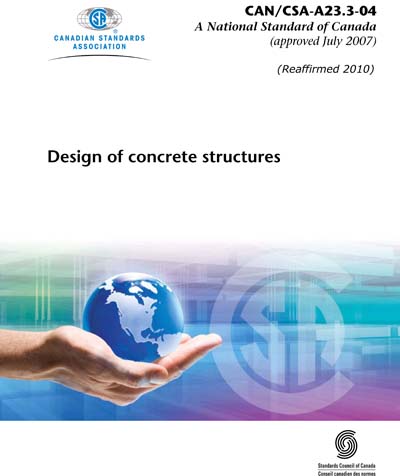Historical
CAN/CSA A23.3-2004 (R2010)
CAN/CSA-A23.3-04 (R2010) - Design of Concrete Structures
Update #2 was published as notification that this is now a National Standard of Canada.
Preface
This is the fifth edition of CSA A23.3, Design of concrete structures.It supersedes the previous editions published in 1994, 1984, 1977 (metric) and 1973 (imperial), and 1959.
This Standard is intended for use in the design of concrete structures for buildings in conjunction with CSA A23.1-04/A23.2-04, Concrete materials and methods of concrete construction/Methods of test and standard practices for concrete, and CSA A23.4, Precast concrete - Materials and construction (under preparation).
1. Scope
1.1 GeneralThis Standard specifies requirements, in accordance with the National Building Code of Canada, for the design and strength evaluation of (a) structures of reinforced and prestressed concrete; (b) plain concrete elements; and (c) special structures such as parking structures, arches, tanks, reservoirs, bins and silos, towers, water towers, blast-resistant structures, and chimneys.
Note: Special requirements for parking structures are specified in CAN/CSA-S413.
1.2 Fire resistance
This Standard requires designs to be carried out in accordance with the fire resistance requirements of the applicable building code (see Clause 8.1.2).
1.3 Alternative design procedures
Designs that use procedures which are not covered by this Standard but are carried out by a person qualified in the methods applied and provide a level of safety and performance equivalent to designs complying with this Standard are acceptable if carried out by one of the following methods: (a) analysis based on generally established theory; (b) evaluation of a full-scale structure or a prototype by a loading test; or (c) studies of model analogues.
1.4 Terminology
In CSA Standards, "shall" is used to express a requirement, i.e., a provision that the user is obliged to satisfy in order to comply with the standard; "should" is used to express a recommendation or that which is advised but not required; "may" is used to express an option or that which is permissible within the limits of the standard; and "can" is used to express possibility or capability.
Notes accompanying clauses do not include requirements or alternative requirements; the purpose of a note accompanying a clause is to separate from the text explanatory or informative material. Notes to tables and figures are considered part of the table or figure and may be written as requirements.
Annexes are designated normative (mandatory) or informative (non-mandatory) to define their application.
1.5 Units of measurement
Equations appearing in this Standard are compatible with the following units: (a) area: mm2 (square millimetres); (b) force: N (newtons); (c) length: mm (millimetres); (d) moment: N.mm (newton millimetres); and (e) stress: MPa (megapascals).
Whenever the square root of the concrete strength is determined, the concrete strength and the square root of the concrete strength are both expressed in megapascals. Other dimensionally consistent combinations of units may be used, provided that appropriate adjustments are made to constants in non-homogeneous equations.
Note: Some examples of non-homogeneous equations are found in Clauses 12.2.2 and 12.8.
CSA America, Inc. [csa]

